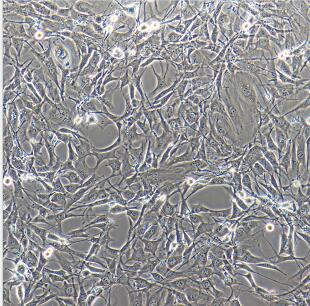| Synonyms: | HMT-3522 S1(人類乳腺上皮細(xì)胞) |
| Background: | HMT-3522 S1, also known as HMT-3522/wt, is a subline that has been derived from HMT-3522. The parent line was established from a benign breast tumour of a 48 year old woman and has undergone spontaneous malignant transformation. It was grown on collagen in serum-free media without antibiotics from explantation onwards. A mutation at codon 179 of the p53 gene was detected during establishment of the parent line. HMT-3522 S1 is a continuation of this line from passage 34 and is grown without collagen. It is near-diploid, but an evolution of karyotype has been observed by regular chromosomal analyses. The expression of cytokeratin 13, 14, 17 and 18 and vimentin has been reported. Expression of EGF-R, c-erb-B2, N-myc, c-ras-Ha1, c-ras-Ki2 and N-ras was shown to fluctuate slightly with passage number. The cells have tested negative for estrogen receptor, c-erbA1, c-erb-A2, int-2 or hst-1. During propagation growth factor requirements decreased simultaneously with amplification and overexpression of c-myc protooncogene. In a three-dimensional basement membrane culture assay the phenotypic characteristics of normal breast tissue in vivo are recapitulated. This cell line has remained non-tumorigenic for more than 400 passages. Publications using this cell line must refer to the original paper (Briand et al., In Vitro Cell Dev Biol 1987; 23:181). Any sublines created must include the name HMT-3522 in the designation, but a short name may be used in the same paper. Subline HMT-3522 S2 (ECACC catalogue no. 98102211) has been isolated by culturing S1 cells from passage 118 in serum-free media without epidermal growth factor (EGF). This cell line grows on collagen-treated flasks. The third subline, HMT-3522 T4-2 (ECACC catalogue no. 98102212) was established from S2 at passage 238 and is the only tumorigenic line in nude mice out of the 3 sublines. This cell line grows on collagen-treated flasks. |
| Species: | human (Homo sapiens) |
| Tissue: | Breast |
| Disease: | Human Caucasian breast epithelial |
| Gender: | N/A |
| Morphology: | Epithelial-like |
| Growth Mode: | Adherent |
| Doubling Time: | N/A |
| DNA Profile: | Amelogenin: X CSF1PO: 11 D13S317: 9,13 D16S539: 14 D5S818: 11,12 D7S820: 11,13 THO1: 8,9.3 TPOX: 8,9 vWA: 14,17 Cell Line Authentication Service |
| Culture Medium: | DMEM / Ham's F12 (1:1) + 2mM Glutamine + 250ng/ml insulin + 10µg/ml transferrin +10E-8M sodium selenite + 10E-10M 17 beta-estradiol + 0.5µg/ml hydrocortisone + 5µg/ml ovine prolactin + 10ng/ml EGF We strongly suggest to purchase the complete medium. |
| Cryopreservation medium: | 90%FBS+10%DMSO |
| Karyotype: | 45,XX,1p-,-6,8q+-,12p+,14q+,17q+ |
| Subculture Routine: | If starting from a frozen ampoule the cryoprotectant should be removed. Add thawed cells to a conical based centrifuge tube e.g. 15ml tube. Slowly add 4 ml of culture medium and re-suspend cells, taking a sample of the cell suspension, e.g. 100μl, to count. Centrifuge the cell suspension at low speed i.e. 100 - 150 x g for a maximum of 5 minutes. Split sub-confluent cultures using 0.25% trypsin or trypsin/EDTA; 5% CO2; 37°C. Cells are slow to detach from the flask. Add the same volume of trypsin inhibitor as trypsin used, centrifuge and reseed cells at 2-4 x10, 000 cells/cm². Medium is serum-free, therefore trypsin inhibitor is essential. S1cells can be slow in spreading out after subculture and may take 2-3 days to attach. Good growth occurs 5-7 days after subculture. Cells should be frozen in (45% conditioned media: 45% fresh media) with 10% DMSO. |
我要詢價
*聯(lián)系方式:
(可以是QQ、MSN、電子郵箱、電話等,您的聯(lián)系方式不會被公開)
*內(nèi)容:









